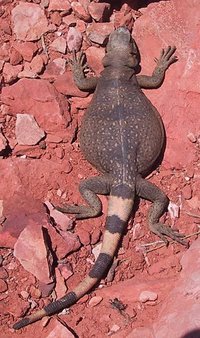Chuckwalla
|
|
| Chuckwallas | ||||||||||||||
|---|---|---|---|---|---|---|---|---|---|---|---|---|---|---|
| | ||||||||||||||
| Scientific classification | ||||||||||||||
| ||||||||||||||
| Species | ||||||||||||||
|
Sauromalus ater |
Chuckwallas (less commonly Chuckawallas) are large, bulky lizards found primarily in arid regions of the southwestern United States and northern Mexico; some are found on coastal islands. There are five species of Chuckwalla, all within the genus Sauromalus; they are part of the iguana family, Iguanidae.
The name Chuckwalla derives from the Shoshone word "tcaxxwal" or Cahullia "caxwal", transcribed by Spaniards as "chacahuala".
Physical description
Reaching a total length of 16 inches (40 centimetres) and a weight of 2 pounds (0.9 kilograms), Chuckwallas are noted for their wide, flattened midsections and prominent paunch. Their tails are also notably thick, tapering to a blunt tip. Loose folds of skin characterise the neck and sides of the body, which is covered in small, coarsely granular scales. Males are generally larger than females.
These lizards are coloured plainly; sexual dimorphism is marked, with males having reddish to orange, yellow or light gray bodies and black heads, shoulders and limbs; females and the immature have bodies with scattered spots or contrasting bands of light and dark in shades of gray or yellow.
Well-developed femoral pores are located on the inner side of the thighs in males; these pores produce secretions believed to play a role in marking territory.
Range, habitat and diet
The genus Sauromalus has a wide distribution in desert biomes. This is especially true of the Common Chuckwalla (Sauromalus ater), found from southern California east to southern Nevada and Utah, western Arizona and south to Baja California and northwestern Mexico. Other species are island-dwelling and therefore have much more restricted distributions: Two rare and endangered are the Chuckwalla de Montserrat (Sauromalus slevini) found on Islas Carmen, Coronados and Montserrat and the San Esteban Chuckwalla or Painted Chuckwalla (Sauromalus varius) found on San Esteban, Lobos and Pelicanos. The Angel Island Chuckwalla (Sauromalus hispidus) and Peninsular Chuckwalla (Sauromalus australis) are found on Isla Angel de la Guarda and surrounding islands off the coast of the Baja California peninsula.
Chuckwallas prefer lava flows and rocky areas, such as those found in the Sonoran and Mojave Deserts. These areas are typically vegetated by creosote bush and other such drought-tolerant scrub. The lizards may be found at elevations of up to 4,500 feet (1,370 metres).
Primarily herbivorous, Chuckwallas feed on leaves, fruit and flowers of both annuals and perennial plants; insects represent a supplementary prey. The lizards are said to prefer yellow flowers, such as those of the brittle-bush (Encelia farinosa).
Behaviour and reproduction
Harmless to humans, these lizards are known to run from potential threats; a tight rock crevice is sought wherein the Chuckwalla will inflate its body with air in order to entrench itself.
Males are seasonally and conditionally territorial; an abundance of resources tends to create a hierarchy based on size, with one large male dominating the area's smaller males. Chuckwallas are visually oriented and use a combination of colour and physical displays, namely "push ups", head-hobbing, and gaping of the mouth to communicate and defend their territory (see animal communication). In lean periods no territories are observed.
Chuckwallas are diurnal animals and as they are exothermic, spend much of their mornings and winter days basking. These lizards are well adapted to desert conditions; they are active at temperatures of up to 102°F (39°C). Chuckwallas hibernate during cooler months and emerge in February.
Mating occurs from April to July, with 5-16 eggs subsequently laid between June and August. The eggs hatch in late September. Chuckwallas may live for 25 years or more.he:צ'קואלה מצויה nl:gewone chuckwalla

